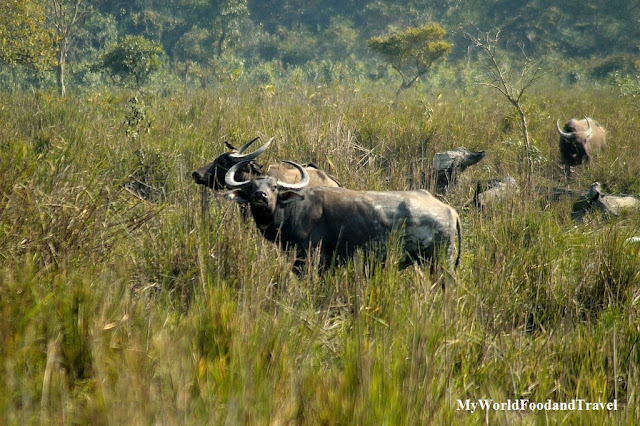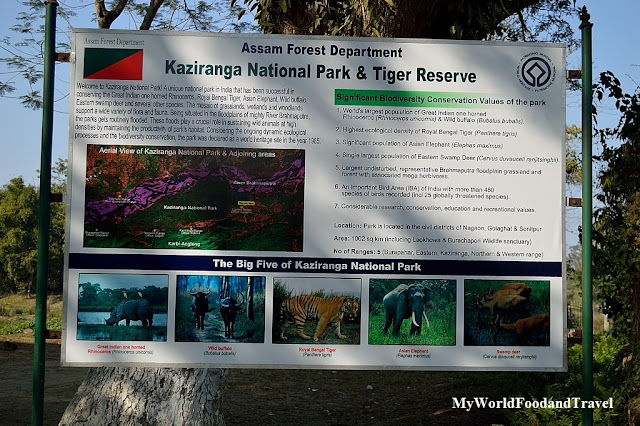An Amazing Trip to Kaziranga: Part 2
We had decided against going for the elephant safari the
next morning. One had to traverse around 40 kms from Agoratoli to Baguri range
to embark on the safari. It was too cold to wake up at 4.30 am to be able to
take the elephant safari which started at 5.00 am, although there were
subsequent trips at 6.00 am and 7.00 am. Mainly, we worried that the baby might
throw tantrums atop an elephant. We were not sure how we could handle the
situation then!
So, the next morning we went on another Jeep safari at 8.00 am. Since
the forest office was located just opposite the resort, not much time was
wasted in completing the safari formalities. This time there were four more
vehicles with us, comprising the other tourists. I wondered if that was a good
idea, as not all of us may be equally enthusiastic about birds and animals.
Sohola Beel
The Jeep took the same route as in the previous trip and our
first stop was Sohola Beel. Here we caught sight of the magnificent griffon
vultures spreading out their wings to catch the morning sun rays. The forest
guard accompanying us informed us that a tiger had killed a buffalo there and
hence the presence of these endangered scavengers. We moved ahead and suddenly the
Jeep ahead of us stopped. One of the persons in that vehicle pointed towards a
tree and it took us a while to acknowledge that the yellow patches in the tree
were not leaves but a couple of yellow footed green pigeon. We clicked away
till the birds got bored and flew off.
Yellow footed Green Pigeon
The wetlands were alive with the various species of birds,
storks and herons having a field day in the morning sun. We noticed the same
birds as in the previous evening but were able to appreciate their beauty more
this time. The vehicles behind us were getting restless and we had to move on. We
entered the forest leaving behind the water birds and a great hornbill flew overhead
with a flutter. The air inside the forest was filled with the shrill screeches
of parakeets. Some way into the forest, we heard the driver of the vehicle
following us call out and stopped. It seemed the Jeep had developed some
problem. While our driver and the forest guard tried to fix the snag, we spent
time observing the various warblers and other smaller birds in the bushes. I was
overjoyed to see the black hooded oriole make its appearance. The driver soon
returned and we continued with our safari.
Suddenly, a group of scarlet minivets flew past us, dazzling
us with their bright red colours. Pity we could not take better pictures. In a
few moments we again reached the point where we had seen the black-necked
stork. The fellow was missing, but there were a number of other birds instead. There
was a lone purple heron along with grey herons and sandpipers. A darter was
sunning itself on a branch while a couple of common redshanks and sandpipers were
wading about the water for their morning meal. The trees along the water were
inhabited by kingfishers, cormorants and a few grey headed fishing eagles. A little
further on, we came upon a family of lazy otters basking in the sun in a sort
of grassy nest. They seemed oblivious to the world and we left them as they
were.
Scarlet Minivet
Darter
Lazy sunbathing Otters
The Jeep lurched forward towards the forest office, which
served to be a break-point for us. Not far from the forest office we heard a
peculiar but very loud cry. “Elephants,” our driver said. “There must be a
tiger around. This is the defensive cry of mother elephants.” We remembered the
herd of elephants with their calves on the previous evening. A tiger! The husband and I silently exchanged excited
glances.
The resort had thoughtfully packed tea and coffee for us and
it boosted up our hope to see a tiger. While we waited for the others to finish
the refreshments we caught sight of several woolly necked storks whirling about
overhead. They were being chased by a black necked stork. Now, who would have
thought that the graceful creature would turn out to be so hostile? In the
meantime, we were being observed by a crested serpent eagle, who was sitting
quietly on a branch near the forest office, unperturbed by the chaos created by
the children on the safari.
Crested Serpent Eagle
We started off on the second leg of our safari and this time
the vehicle took us deeper into the jungle. We passed by a water body where a
rhino was waddling about without a care in the world. We stopped and waited
till he came out of the water. Our mind was still fixed on getting those woolly
necked storks and hence kept our sight on the trees. Many a times, we mistook
ant-nests in the trees to be some birds. Just as we dismissed one such figure
as an ant-nest, it showed slight movement. That figure turned out to be an
adorable Asian barred owlet.
Asian Barred Owlet
Our driver on that day was quite knowledgeable and he kept
on informing us about various birds and animals in the area as well as some
gossips on tourist habits and their strange ways. He showed us the pug marks of
a tiger on the road, which were made some 3-4 months back during the monsoons. Suddenly,
he sat back rigidly. “There are very recent pug marks on the ground. I had not
seen them yesterday,” He said. I could almost hear the tiger roar!
Old tiger pug marks
The husband and I kept our eyes peeled out while the Jeep
barged through the jungle. Every shadow and bush seemed like a tiger to us. The
last time a tiger was witnessed in these parts were two weeks back. We had seen
the picture posted on Facebook. Were we going to be the lucky ones? Apparently
not. This we realized after driving around for more than an hour. We had missed
seeing the tiger once in Bhadra Wildlife Sanctuary during a boat safari. I hope our luck turns.
It was around 11.30 am and the birds had almost disappeared.
We passed through tall elephant grasses on our return journey and caught sight
of a large family of wild buffaloes. Just as we were about to reach the gates
of the National Park, we heard the beautiful strain of the oriental honey
buzzard bidding us adieu. What a fitting
goodbye! And so, we set out of Kaziranga with a number of precious memories
stored in our minds.
Now, let me share
with you a few important pointers and links:
2. It is extremely dusty inside the jungle due to the mud tracks. So, take care of your photography equipment and wear some kind of a windcheater.
3. The drive is very, very bumpy. In case you are prone to severe back aches or suffer from some other related ailments you may want to re-think.
4. The afternoon Jeep safari is best for spotting animals while the morning safaris work out well for birding.
5. Some links you may want to look up on the internet:
·
http://en.wikipedia.org/wiki/Kaziranga_National_Park
·
http://www.kolkatabirds.com/kaziranga.htm
·
http://www.kaziranga-national-park.com/
Areas of concern:
Proliferation of illegal settlers in the National Park. No
menace is greater than the menace posed by humans. Pessimistic as I may
sound, but there is no solution to this problem.
Rampant poaching and killing of rhinos. Every morning there
is a report of at least 2 rhinos killed within 24 hours. My dad, who spent more
than 20 years of his life in conserving wildlife, has given up all hope. Before
we left for Kaziranga, he looked at our excited faces and warned that we may
not like what we see there. “The animals have become aggressive. They sense
danger everywhere, they are hungry and they have nowhere to turn to. These
animals and birds have no future here. Nobody can save them - it is a lost
cause.” I sensed his bitterness, his angst in seeing his beloved birds, animals
and forests getting depleted and killed everyday. But is there really no hope? I
leave that to you to decide.
Complete list of birds sighted in Kaziranga (could not identify many):
Greater Spotted Eagle, Grey headed Fishing Eagle, Changeable Hawk Eagle, Griffon Vulture, Common Redshank, Common Sandpiper, Wood Sandpiper, Cattle Egret, Intermediate Egret, Lesser Adjutant Stork, Black-necked Stork, Woolly necked Stork, Yellow footed Green Pigeon, Spotted Dove, Long tailed Shrike, Common Kingfisher, Stork billed Kingfisher, Rufous Treepie, Ruddy Kingfisher, White breasted Kingfisher, Purple Heron, Grey Heron, Darter, Little Cormorant, Mallard, Bar headed Geese, Gadwall, Eurasian Widgeon, Rudy Shelduck, Northern Pintail, Spot billed Pelican, Black hooded Oriole, Scarlet Minivet, Chestnut Tailed Starling, Red vented Bulbul, Jungle Mynah, Crested Serpent Eagle, Oriental Honey Buzzard, Rose ringed Parakeet, Warblers (could not identify), Asian Barred Owlet, Northern Lapwing, Grey headed Lapwing, White Wagtail, White browed Wagtail, Yellow Wagtail, Citrine Wagtail, Great Hornbill, Open billed Stork.
Animals sighted in Kaziranga:
Great One-horned Rhinoceros, Hog Deer, Sambar Deer, Wild Buffalo, Indian River Otter (?), Elephants, Capped Langur.
Complete list of birds sighted in Kaziranga (could not identify many):
Greater Spotted Eagle, Grey headed Fishing Eagle, Changeable Hawk Eagle, Griffon Vulture, Common Redshank, Common Sandpiper, Wood Sandpiper, Cattle Egret, Intermediate Egret, Lesser Adjutant Stork, Black-necked Stork, Woolly necked Stork, Yellow footed Green Pigeon, Spotted Dove, Long tailed Shrike, Common Kingfisher, Stork billed Kingfisher, Rufous Treepie, Ruddy Kingfisher, White breasted Kingfisher, Purple Heron, Grey Heron, Darter, Little Cormorant, Mallard, Bar headed Geese, Gadwall, Eurasian Widgeon, Rudy Shelduck, Northern Pintail, Spot billed Pelican, Black hooded Oriole, Scarlet Minivet, Chestnut Tailed Starling, Red vented Bulbul, Jungle Mynah, Crested Serpent Eagle, Oriental Honey Buzzard, Rose ringed Parakeet, Warblers (could not identify), Asian Barred Owlet, Northern Lapwing, Grey headed Lapwing, White Wagtail, White browed Wagtail, Yellow Wagtail, Citrine Wagtail, Great Hornbill, Open billed Stork.
Animals sighted in Kaziranga:
Great One-horned Rhinoceros, Hog Deer, Sambar Deer, Wild Buffalo, Indian River Otter (?), Elephants, Capped Langur.


















Comments
Post a Comment